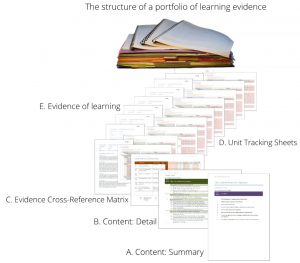Completing the assessment portfolio bk
Information for pilot users
Thank you very much for taking the time to review this short portfolio-building training resource.
Too many trainees are not clear on how to build their portfolio without errors, so costing both the trainee and their assessor valuable time and energy. These errors include:
- insufficient understanding of portfolio structure
- issues with unique reference numbers for individual pieces of evidence
- the confident setting of pieces of evidence against all appropriate performance criteria (PCs), including, where appropriate, PCs from different units
- using unit specifications and PCs creatively to plan evidence gathering independently of their assessor
- creating a portfolio that is easy for all parties to navigate
- using a wider variety of evidence with which to demonstrate range and scope.
Our hope is that this short training programme will save trainees and assessors a great deal of ‘preventable contact’ time, and increase the engagement, enjoyment and fulfilment of completing their qualification.
Please download the workbook and work through the six short sections. We would be grateful if you could also read and (particularly for trainees) complete the short tasks at the end of most sections in the workbook. At the end, there is a Memory Survey as part of the resource, and also a brief Pilot Survey, which is designed to formalise your feedback to the development team. The total running time of the videos is just 16 minutes. You may wish to note down feedback comments as you work through the resource.
Please note that with the exception of the blue text, all of the text below is simply the transcript of the video narration to aid reflection. Everything is contained in this one webpage. Please make a note of the time when you begin using this resource, so that you can see how long you have spent on the training.
Thank you very much, from Tony and the development team!
Programme overview
- This training programme is a step-by-step guide to completing a portfolio of assessment evidence.
- It contains six very short instructional videos, with a total running time of 16 minutes.
Target audience
- Trainees completing a portfolio of evidence to demonstrate competence against a qualification’s assessment criteria, such as: NVQs and apprenticeships.
- Assessors who monitor trainees’ progress and their completion of portfolios of evidence.
Learning outcomes
By the end of the training, users will be able to:
- look forward to the building of their portfolio and set out a strategy for the production of a clearly organised file, forms and evidence of learning
- add Unique Reference Numbers to their evidence of learning
- determine if a piece of evidence meets a required assessment criterion and, where appropriate, cross-reference this evidence to all relevant assessment criteria
- complete the Unit Tracking Sheets accurately
- complete the Contents Page accurately
- complete the Evidence Cross-Reference Matrix accurately
- build a well-organised portfolio of evidence that is easy to navigate and a resource for the future.
Course structure
- Episode 1 – Building a rewarding portfolio of evidence
- Episode 2 – Types of evidence
- Episode 3 – Adding unique reference numbers
- Episode 4 – Using the Unit Specification creatively
- Episode 5 – Monitoring progress and navigating your portfolio
- Episode 6 – A recap on the structure and purpose of your portfolio
- Memory survey
- Pilot users’ survey
How to use this training resource
Download the accompanying workbook then watch the short videos below. The workbook contains transcripts of each video together with important tasks to help build your skills and understanding.
Episode 1 Building a rewarding portfolio of evidence
Content
- The basic content of a portfolio
- Building a portfolio is rewarding
Duration: 1:31
Transcription
This short training programme will teach you how to write your very own book – a book full of the illustrations and experiences you collect on the journey towards completing your work-based learning qualification. A book that represents the reward for your investment and study.
Studying for any qualification is an uplifting, enriching experience, but with work-based learning qualifications centred on the building of a portfolio, there’s this significant added benefit:
the feeling that you are becoming a collector, a curator and an author.
The purpose of this training programme is to help you record that journey in the most effective and efficient way, while inspiring you to seek out a variety of experiences and evidence that will help you demonstrate and record your learning and abilities against each of your qualification’s assessment criteria.![]()
And here’s what your finished book – your portfolio – might look like.
It’s basically made up of three elements:
- the Evidence of your learning
- Unit Tracking Sheets to show how this evidence demonstrates your learning and your competence, and
- a Contents Page, so that you can find anything with ease.
Next lesson
In the next episode, we’ll look at the many different types of evidence you can collect… and you might just find that these inspire you to seek out learning experiences in many different ways.
Summary
- Producing a portfolio of evidence is an engaging and rewarding activity.
- If you study the portfolio-building process you will save time and make the most of your work and learning experiences.
- A portfolio is made up of three elements:
- Evidence of learning
- Unit Tracking Sheets
- a Contents Page.
Over the next five short episodes, we’ll help you understand the whole structure of the portfolio, as can be seen in the image below.
Episode 2 Types of evidence
Content
- Identifying the many types of evidence that can be used to build a portfolio
Duration: 2:44
Transcription
Evidence of your learning can be shown in a variety of ways. In this episode, we’re going to look at the most common types of evidence you might include in your portfolio.
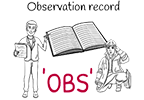 An Observation Record (OBS) is written by a trainee’s trainer/assessor after watching them carry out an activity; an activity that demonstrates they are competent in one or more of the qualification’s assessment criteria.
An Observation Record (OBS) is written by a trainee’s trainer/assessor after watching them carry out an activity; an activity that demonstrates they are competent in one or more of the qualification’s assessment criteria.
A Witness Testimony (WT) is similar to an observation record – it’s a written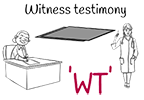 account of a trainee’s performance, but this time made by someone other than the trainer/assessor; a person qualified to make a professional judgement about what they’ve just seen.
account of a trainee’s performance, but this time made by someone other than the trainer/assessor; a person qualified to make a professional judgement about what they’ve just seen.
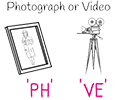 A Photograph (PH) or Video (VE) of a trainee carrying out an activity can also contribute to evidence of their competence, as can a visible output of their work role, which is known as a Work Product (WP). Naturally, these will vary greatly depending on your particular occupation.
A Photograph (PH) or Video (VE) of a trainee carrying out an activity can also contribute to evidence of their competence, as can a visible output of their work role, which is known as a Work Product (WP). Naturally, these will vary greatly depending on your particular occupation.
 Writing answers to specific Questions (Q) is an ideal way for trainees to demonstrate understanding to their trainer/assessors. Questions can, of course, be verbal, though thought would need to be given to how these might be recorded so that they can contribute well to the trainees’ evidence base and portfolio.
Writing answers to specific Questions (Q) is an ideal way for trainees to demonstrate understanding to their trainer/assessors. Questions can, of course, be verbal, though thought would need to be given to how these might be recorded so that they can contribute well to the trainees’ evidence base and portfolio.
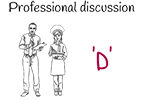 Professional Discussion (D) between the trainee and their trainer/assessor can allow them to demonstrate a wider understanding of a subject than simply answering specific questions. While these should be genuine discussions, they must be led by the trainee rather than the trainer/assessor. The aim is still for the trainee to demonstrate they are competent in one or more of the qualification’s assessment criteria.
Professional Discussion (D) between the trainee and their trainer/assessor can allow them to demonstrate a wider understanding of a subject than simply answering specific questions. While these should be genuine discussions, they must be led by the trainee rather than the trainer/assessor. The aim is still for the trainee to demonstrate they are competent in one or more of the qualification’s assessment criteria.
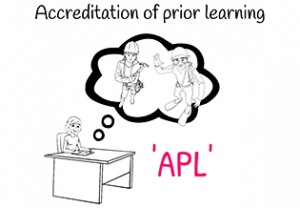 A trainee may be able to claim competence for some of the assessment criteria by presenting the work they completed in their professional life before beginning the programme. This Accreditation of Prior Learning (APL) helps prevent needless repetition and can increase trainees’ motivation and rate of progress.
A trainee may be able to claim competence for some of the assessment criteria by presenting the work they completed in their professional life before beginning the programme. This Accreditation of Prior Learning (APL) helps prevent needless repetition and can increase trainees’ motivation and rate of progress.
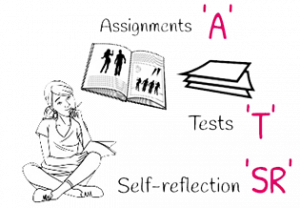 Other forms of evidence include completed Assignments (A) and formal Tests (T), as well as trainees’ own Self-reflection (SR) on the learning they’ve gained from particular experiences. These allow trainees to demonstrate to themselves, and their trainer/assessors, how their learning is progressing. Testing their theory knowledge in this way, builds trainees’ confidence in what they now know, while identifying any gaps they’re yet to fill.
Other forms of evidence include completed Assignments (A) and formal Tests (T), as well as trainees’ own Self-reflection (SR) on the learning they’ve gained from particular experiences. These allow trainees to demonstrate to themselves, and their trainer/assessors, how their learning is progressing. Testing their theory knowledge in this way, builds trainees’ confidence in what they now know, while identifying any gaps they’re yet to fill.
Evidence of competence, then, can take on many different forms, and categories can be abbreviated as required depending on the specialisms in your qualification.
Next lesson
In the next episode, we’ll look at how to organise all of this evidence using Unique Reference Numbers.
Summary
Evidence of competence can take on many different forms, including:
- OBS Observation Records
- WT Witness Testimonies
- PH Photographs
- VE Videos
- WP Work Products
- Q Answers to questions
- D Professional Discussion
- APL Accreditation of Prior Learning
- A Assignments
- T Tests
- SR Self-reflection
Other categories can be abbreviated as required depending on the specialist area of your qualification.
Task
Consider your work role while reading the types of evidence on page 6 of your workbook. Your task is to write two or three possible examples of evidence for each type.
Additional challenge
Make references to specific assessment criteria from your qualification for each example.
Episode 3 Adding unique reference numbers
Content
- Choosing a Unique Reference Number system
- Examples of referenced evidence
Duration 1:37
Transcription
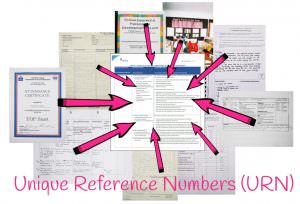 In this episode, we’ll look at how to organise all of your evidence of learning using Unique Reference Numbers.
In this episode, we’ll look at how to organise all of your evidence of learning using Unique Reference Numbers.
A completed portfolio – the illustrations and accounts of all of your learning – may contain hundreds of pieces of evidence. So it’s important at the outset to create a referencing system that enables you to use each piece of evidence efficiently.
In other words, to claim all of the appropriate learning outcomes and performance criteria to which the evidence relates. And as you can imagine, this greatly speeds up the completion of your qualification.
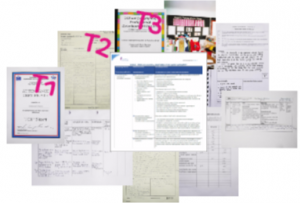 You’re free to devise your own numbering system as long as it follows two simple rules:
You’re free to devise your own numbering system as long as it follows two simple rules:
- the number you give to each piece of evidence must be unique, and
- you must use the same system throughout the whole portfolio.
You may simply wish to use the first letter of your name followed by a number.
Such as (for Tony): T1, T2, T3, etc..
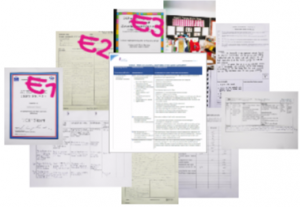 Or you might choose ‘E’ for ‘evidence’:
Or you might choose ‘E’ for ‘evidence’:
So that would be: E1, E2, E3, and so on…
You may even wish to include in the type of evidence you’re recording, alongside each unique number. For instance:
E1 (OBS)
E2 (WT)
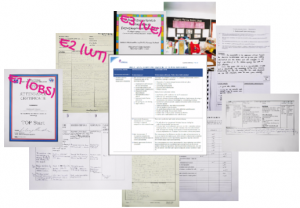 E3 (VE), and so on.
E3 (VE), and so on.
As long as you are consistent and each number is only used once, you can use whatever system is most meaningful to you.
Next lesson
In the next episode, we’ll look at how to use a Unit Specification creatively, and how to determine if a piece of evidence enables you to claim competence for a specific performance criteria.
Summary
- You’re free to devise your own referencing system – Unique Reference Numbers (URN)
- The number you give to each piece of evidence must be unique
- You must use the same system throughout the whole portfolio.
Task
To decide on the Unique Referencing System you intend to use.
Episode 4 Using the Unit Specification creatively
Content
- How to determine if a piece of evidence meets the claimed criterion
- Using the unit specification to plan learning
Duration: 3:07
Transcription
In this episode, we’ll look at how to use a Unit Specification creatively and how to determine if a piece of evidence contributes towards your qualification.
A unit’s Learning Outcomes and Performance Criteria set out an exciting vision of your future self – all of the things you’ll be able to do as a result of your next period of study.
Throughout these studies, you’ll be carrying out tasks as part of your work-role alongside the assignments and projects set by your trainer/assessor. All of this is designed to help you learn new skills, gain new insights, and develop confidence in your role.
So your constant focus should be on collecting evidence that clearly shows every one of these changes.
- If you learn a new skill, what evidence do you have that shows this?
- If you gain a new insight, what’s the evidence that demonstrates this new insight?
Let’s start by looking at an easy example from the Trainer/Assessor Diploma. This is Aya, and she’s working on Unit 2. Once she’s completed this unit, she’ll know how to: ‘Plan the assessment of a trainee’s occupational competence in a work environment’. But what evidence will show that she can effectively plan these assessments?
Here is Aya’s overview/planning document. It sets out: her trainees’ names, work roles, and employers, along with the dates she’s scheduled for each assessment and the competence she plans to assess.
Supporting this overview, Aya has also produced a detailed plan for each visit, setting out:
- how she intends to carry out the assessment, and
- the questions she intends to ask.
So let’s annotate a copy of Unit 2’s requirements to see which performance criteria these two pieces of evidence would enable Aya to claim. As we can see, Aya can claim the first three elements of performance criteria 1.1. But now it’s time for a little creative thinking, as it’s become clear to Aya that she hasn’t planned to:
- ask the trainees for Self-Reflection statements about the learning experiences she wasn’t able to see.
Nor has she looked at how to support her assessment through the use of:
- Witness Testimonies from the trainees’ work-place supervisors (1.1e).
Using the Unit 2 specification in this way enables Aya to carefully consider the precise skills she needs to develop as an assessor, and also the specific pieces of evidence she’ll need to be able to claim each of the performance criteria for this unit.
In summary then, the Unit specifications are a creative tool for:
- planning your learning experiences
- and understanding the evidence you’ll need to collect along the way.
Next lesson
In the next episode, we’ll look at how Aya records her new skills and navigates her portfolio using Unit Tracking Sheets and Contents pages.
Summary
- Unit Specifications are a creative tool to help you plan your learning.
- Your evidence of learning is a record of how you have changed – the skills and insights you now have.
Task
There are three tasks to complete on pages 10 and 11 of your workbook.
- Task 1 – Beginning with your work role
- Task 2 – Beginning with the Unit Specification – easy
- Task 3 – Beginning with the Unit Specification – hard
Episode 5 Monitoring progress and navigating your portfolio
Content
- Navigating your portfolio using Contents Pages
- Monitoring your progress using Unit Tracking Sheets
- Using a piece of evidence to satisfy more than one performance criteria
- Cross-referencing evidence to multiple units
Duration 5:10
Transcription
In this episode, we’ll look at four forms that will make studying easier and turn your portfolio into a resource for the future, as well as one that will help you pass your qualification now.
 Contents Pages and Tracking Sheets are general terms covering different styles of form depending on your qualification and level, so it’s important that we begin with a clear understanding of what each type of form is for.
Contents Pages and Tracking Sheets are general terms covering different styles of form depending on your qualification and level, so it’s important that we begin with a clear understanding of what each type of form is for.
Think of the two main ways your portfolio is used. Both you and your assessor need to:
- navigate your evidence base, and
- track your progress.
Let’s start with navigation. Imagine for a moment that Aya’s portfolio is now complete and ready for assessment. Her assessor needs to be able to find their way around her work quickly. Using a Contents: Summary page, enables the assessor to see the overall structure of Aya’s portfolio free of any other distracting text.
The Contents: Detail pages, however, include all of the performance criteria, which act like the individual chapter headings of a book.
Both of these forms are located at the front of Aya’s portfolio and enable her and her assessor to find what they’re looking for very quickly. And with the addition of a ‘key dates’ section, Aya, her assessor and the internal and external verifiers can keep a careful check on progress.
Now let’s travel back to the point at which Aya completed her very first piece of evidence for Unit 1. This was an assignment on the Principles of Assessment. Her assessor was confident about its quality, so Aya can now set this one piece of evidence against all of the performance criteria it covered.
There’s one of these detailed forms for each unit in your qualification; they’re called: Unit Tracking Sheets. These help you monitor your progress, but they also act as mini contents pages for each section of your portfolio.
That’s almost all you need to know about these really useful forms, but there is one more that could save you a great deal of time. It’s another contents page for the front of your portfolio and it’s for cross-referencing your many pieces of evidence to the criteria they cover. So how does this form help?
Aya had a professional discussion with her assessor focused on:
Unit 4, performance criteria 4.1:
‘Explain the importance of involving the student/trainee and others in the assessment process’.
Through this discussion, she also managed to cover:
‘Communicating assessment requirements to students’,
which is from Unit 1, performance criteria 1.3.3.
In other words, this new piece of evidence meets criteria from different units, and the Evidence Cross-Reference Matrix enables Aya to keep track of these crossovers.
This matrix is also extremely useful for locating specific pieces of work as it’s the only contents page that uses the titles of your individual pieces of evidence.
By logging every piece of evidence in both the Unit Tracking Sheets and the Evidence Cross-Reference Matrix you make the most of all of the work you complete. These forms can greatly speed up the completion of your qualification.
The look of these forms varies depending on the qualification and whether the portfolio is paper-based or on line. And the forms used here are for illustration purposes only.
Contents pages and tracking sheets, then, are the key to an easy life, a well-organised portfolio, and a resource you’re sure to refer back to time and again. And that’s all there is to building a wonderful portfolio of learning evidence – your very own book that tells the story of your learning journey.
Next lesson
The next and final episode is a really useful visual recap of the whole portfolio. And there’s also a Memory Survey to help you check what you’ve learnt so far, and some important Top Tips on how to speed up the completion of your qualification, enjoy your learning experience even more, and maybe also how to be recognised for the expert-learning skills it will help you develop.
Summary
- The Contents Pages and Unit Tracking Sheets save you time and ensure you use your learning experiences to claim competence for the maximum number of performance criteria.
- These forms allow you to see any gaps in your learning so that you never miss a work-role opportunity to record evidence of competence and learning.
- The Evidence Cross-Reference Matrix is the only place you record the title of your evidence, and so is a particularly useful memory aid as your portfolio grows in size and complexity.
- The format of Contents Pages and Unit Tracking Sheets are unique to each awarding body and style of portfolio, but their function remains the same in each.
- The documents used in this training resource are for reference purposes only
Tasks
- Please complete the Evidence Cross-Reference Matrix task in your workbook.
Episode 6 A recap on the structure and purpose of your portfolio
Content
- The overall structure of your portfolio
Duration 1:59
Transcription
In this final episode, we’ll take a visual tour of the portfolio so that you can see how everything fits together.
Section A Contents: Summary. This shows just the individual unit titles in your portfolio – the chapter headings of your book.
Section B Contents: Detail. This form shows all of the performance criteria in each of the units, and allows you, your assessors and verifiers to keep track of your progress.
Section C The Evidence Cross-Reference Matrix enables you to set single pieces of evidence against multiple Performance Criteria.
Section D Unit Tracking Sheets. There’s a tracking sheet at the start of each unit, and behind each of these are the many and varied pieces of Evidence you’ve collected on your learning journey.
There are thousands of portfolio-based qualifications available, and these four basic forms may look slightly different in each of them. But as long as you remember where they fit and what they’re for, it doesn’t matter how they look.
Thank you very much for watching these six short lessons on how to build an effective portfolio. It would be good practice to review them several times to make sure you have a clear picture of the process, the forms and their benefits.
And remember, your portfolio, and your qualification, is a stepping stone to being a highly skilled and competent asset to the world of work – where hopefully you will continue to be curious, to study, and to master your chosen profession.
Next steps
Taking the Memory Survey below will help you see what you’ve remembered so far. And reading the Top Tips section is sure to speed up the completion of your qualification and make your studies an enjoyable and rewarding experience. These tips will also equip you with the independent, expert-learning skills you’ll need to unlock your future.
Tasks
- Take the Memory Survey, reflect on any knowledge gaps it identifies, then re-read the material above and/or discuss the results with your trainer/assessor. Next-step suggestions are provided for any wrong answers. The survey can be found here:
- Read the Top Tips section in your workbook, then carry out the activities it suggests.
Pilot users’ feedback survey
Thank you again for taking the time to be part of the pilot for this resource. Your feedback is essential to ensure we achieve our goals. Please take our 15-question survey to complete the pilot, and thank you again, from Tony and the development team.



